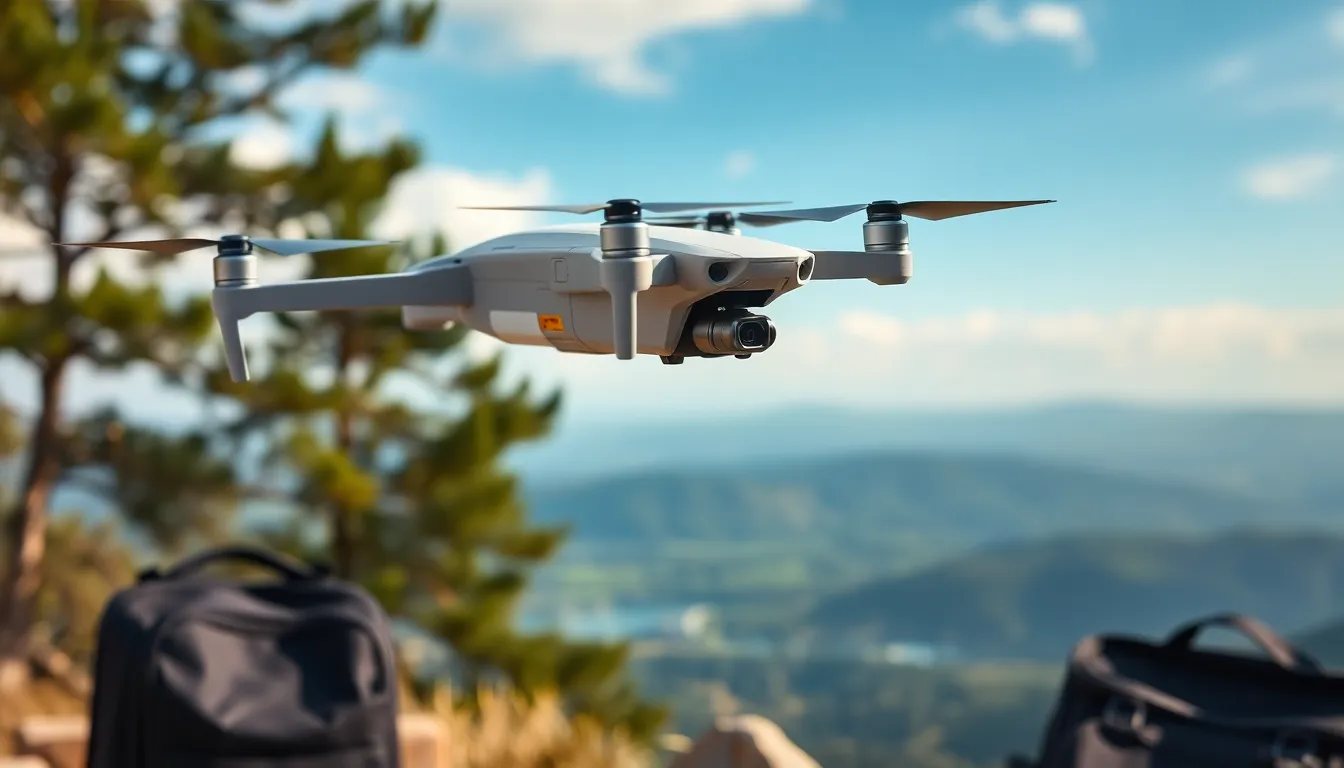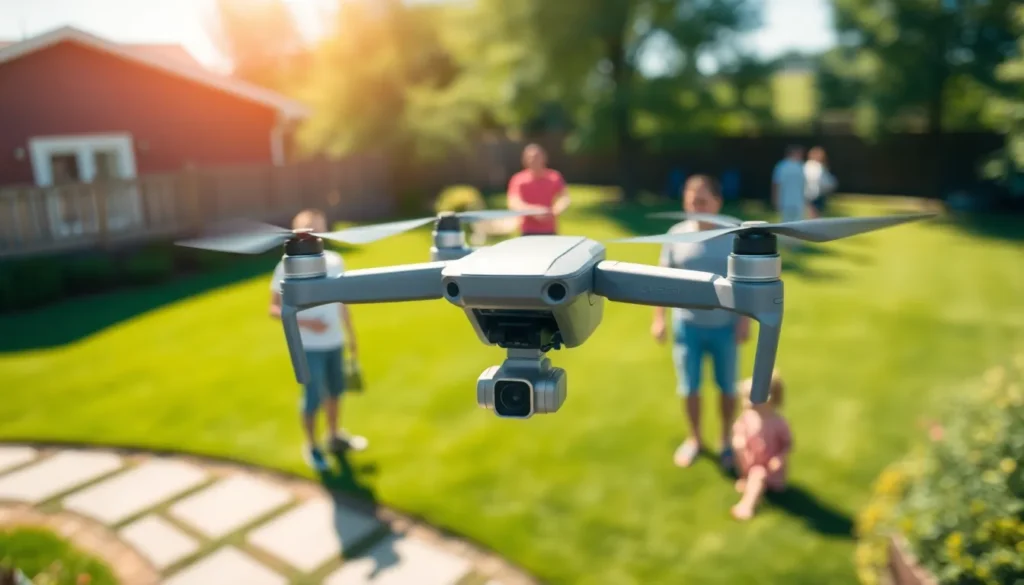Drones are soaring to new heights, and compact designs are leading the charge. Imagine a flying gadget that fits in your backpack yet packs a punch with its features. These little marvels are perfect for capturing stunning aerial shots or scouting your backyard for that pesky squirrel. Who knew that something so small could make you feel like a high-tech spy?
Table of Contents
ToggleOverview of Drones With Compact Design
Drones with compact design offer significant advantages in terms of portability and functionality. Manufacturers prioritize lightweight materials, enabling users to easily transport these devices. High-definition cameras often feature in these drones, enhancing their capability to capture stunning aerial imagery.
Compact drones excel in versatility, serving various purposes such as recreational flying and professional photography. Their small size allows for maneuverability in tight spaces, making them ideal for urban environments. Users find these drones suitable for personal hobbies, like capturing moments during family outings.
Some models provide extended battery life, allowing longer flight times despite their size. Manufacturers equip compact drones with advanced stabilization technology, ensuring steady footage even in windy conditions. The integration of GPS features enhances navigation, making it easy for users to plan flight paths.
Safety remains a top priority in the design of these drones. Many come with built-in collision avoidance systems, reducing the risk of accidents, especially for beginners. Users appreciate the straightforward setup and operation, as these drones often include intuitive controls.
The compact design also means affordability for a wide range of customers. Various options cater to different budgets, making aerial photography more accessible than ever. Environmental sustainability is a growing concern, and some manufacturers focus on creating energy-efficient models that minimize their ecological footprint.
In addition, the community surrounding compact drones thrives, with numerous online forums and social media groups dedicated to sharing tips and experiences. Innovations in technology continue to drive the evolution of compact drones, ensuring they remain relevant in an increasingly competitive market.
Advantages of Compact Drones

Compact drones provide numerous benefits, making them increasingly popular among users. Their small size accommodates various applications while enhancing overall user experience.
Portability and Storage
Portability stands out as a major advantage of compact drones. Their lightweight structure allows easy transport in backpacks or small cases. Storing these devices poses no challenge, as they fit into tight spaces commonly found in homes or cars. Users appreciate their convenience when traveling, whether for outdoor adventures or professional assignments. The ability to quickly deploy and pack the drone proves advantageous.
Versatility in Use
Versatility defines the capabilities of compact drones. These devices serve a myriad of functions, from stunning aerial photography to surveying properties. Equipped with high-definition cameras, compact drones satisfy hobbyists and professionals alike. Their maneuverability makes them ideal for urban environments, enabling effortless navigation around obstacles. Moreover, compact drones adapt to various conditions, whether for recreational use or serious business applications. Users tap into these multifunctional devices for everything from inspection work to creative storytelling.
Popular Models in the Market
Several compact drone models dominate the market due to their advanced capabilities and user-friendly designs. Each option caters to different preferences and requirements.
Model Comparison
Comparisons among popular models reveal distinct advantages. The DJI Mini 2 stands out for its lightweight design and high-resolution camera. Parrot Anafi offers unique 4K HDR video capabilities and an ultra-compact form factor. Holy Stone HS720 boasts impressive battery life and enhanced stability features. These models offer features appealing to both hobbyists and professionals. Price points vary, with options ranging from $100 to $800, accommodating diverse budgets.
Features and Specifications
Specifications enhance compact drones’ functionality. High-definition cameras are standard, with many models providing 4K video recording. Battery life on popular models averages 20 to 30 minutes, ensuring extended flight times. Advanced GPS technology allows for precise navigation, and some include intelligent flight modes for automated control. Safety is prioritized through built-in collision avoidance systems. These features collectively enhance user experience, making compact drones suitable for various applications, from photography to surveying.
Applications of Compact Drones
Compact drones serve diverse purposes, making them valuable in various contexts.
Recreational Use
Many enthusiasts use compact drones for recreational activities. These devices capture high-quality aerial photos, allowing users to document family outings or scenic landscapes. Their lightweight design enables easy transport, while user-friendly controls make flying accessible for beginners. The thriving community around drones encourages shared experiences, whether capturing stunning videos or engaging in friendly competitions. Compact models also fit well in backpacks, ensuring portability for spontaneous outdoor adventures. As a result, they empower hobbyists to explore their surroundings from unique perspectives.
Professional Use
Professionals leverage compact drones for numerous applications. In fields like real estate, these devices provide aerial imagery that enhances property listings. Surveying teams utilize drones for mapping and inspecting hard-to-reach areas efficiently. Compact models equipped with high-definition cameras deliver crystal-clear visuals, essential for projects requiring precision. Moreover, industries such as agriculture adopt these drones for monitoring crops and assessing land use effectively. Advanced features, including GPS and stabilization technology, assure reliability during active operations, making compact drones indispensable tools for modern professionals.
Future Trends in Compact Drone Design
Compact drones continue to evolve, driven by technological advancements. Increased miniaturization leads to improved performance in small packages. Innovations in battery technology significantly extend flight times, enhancing usability during outdoor activities and professional tasks. Materials science plays a crucial role, with lightweight yet durable materials improving drone resilience.
Enhanced AI capabilities contribute to more intelligent flight operations. These features enable drones to analyze environments in real-time, providing superior obstacle avoidance and automated flight patterns. Integration of 5G technology promises faster data transfer, allowing for high-quality live streaming and improved communication between drones and operators.
User preference shifts toward customizable designs. Manufacturers emphasize modular components, enabling users to tailor drones for specific tasks, such as aerial photography, mapping, or search and rescue. This flexibility meets diverse needs in both recreational and professional markets.
Sustainability becomes a priority in drone development. Eco-friendly designs utilize energy-efficient motors and recyclable materials, appealing to environmentally conscious consumers. Companies increasingly focus on reducing the carbon footprint associated with drone manufacturing and operation.
Collaborations between tech companies and drone manufacturers spur innovation. Expect partnerships to produce cutting-edge features, creating compact drones that outperform traditional models in various applications. This trend ensures competitive pricing while improving technology accessibility for a wider audience.
A growing interest in urban aerial mobility influences compact drone design. As cities adopt drone delivery systems, the need for compact, nimble devices increases. Compact drones equipped with advanced navigation systems will shape the future of urban transportation and logistics.
Compact drones are revolutionizing the way people capture images and utilize aerial technology. Their lightweight design and advanced features make them accessible for both hobbyists and professionals. With applications ranging from stunning photography to essential surveying tasks, these drones offer incredible versatility.
As technology continues to advance, the future looks bright for compact drones. Innovations in battery life and AI capabilities promise even greater functionality. The growing emphasis on sustainability and customization will likely attract a broader audience.
Overall, compact drones are not just a trend; they represent a significant shift in how aerial technology can enrich personal and professional experiences.

